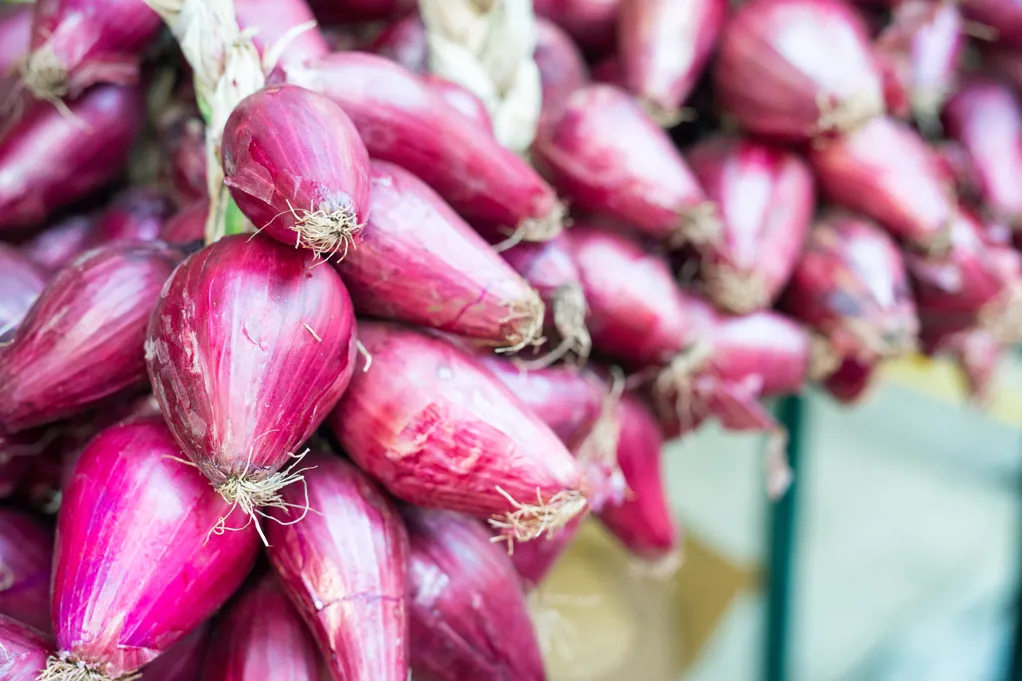Known fondly as la regina rossa – the red queen – by Italians, Tropea onions are among the sweetest and most delicious onions in the world. We head to the beautiful Calabrian seaside town of Tropea to find out what makes these iconic alliums so special.
Amalfi and Sorrento in Campania may grab all the attention from tourists, but 400 kilometres down the coast, Calabria boasts some equally stunning coastlines. The scenery in the south doesn’t boast the gleaming, postcard-perfect beauty of the Sorrentine Peninsula, but it’s far more dramatic – all jagged rock formations, dusty plains and towering cliffs that look out, stony-faced, towards the sparkling cobalt blue of the Tyrrhenian Sea.
Of all the dramatic sights in Calabria, they don’t come more striking than the old Basilian monastery of Santa Maria dell’Isola. Sitting proudly on top of a giant rock just offshore from the coastal town of Tropea, the medieval church rises out of the ocean surrounded by sheer walls and cliff faces. Originally built between the sixth and ninth centuries, the monastery has suffered at the hands of multiple earthquakes, and has been rebuilt many times over. Today it stands as an iconic image of Calabria – not just the perfect summation of Calabria’s rugged beauty, but also of its people’s indefatigable spirit.
There are other iconic images in Calabria, though: fields of bright yellow liquorice flowers in Rossano, endless groves of citrus and bergamot around Reggio Calabria, and huge chestnut forests around Spilinga, where locals string up thousands of links of ‘nduja in old sheds and outhouses. Along the steep cliffs of Tropea and around the coast to the towns of Zambrone, Briatico and Cape Vaticano, farmers grow another Calabrian speciality – Cipolle Rosse di Tropea, otherwise known as Tropea onions.
Known for their amazing sweetness and aroma, the origins of the Tropea onion are largely unknown, but they almost certainly didn’t begin life on the Tyrrhenian coast. There’s a consensus among food historians that the onions probably arrived on the Italian peninsula via the Phoenicians and Greeks, who sailed and traded across much of the Mediterranean sea some 3,000 years ago. By the medieval period, Tropea had well and truly claimed the bright red allium as its own – numerous accounts from this period refer to red onions from Tropea. Though the onions grow all over the region, the sandy soil and more moderate climate near the coast produces the sweetest onions of the bunch. A good Tropea onion is far, far sweeter than your average red onion, but contrary to popular opinion, this isn’t because they have a higher sugar content. In actual fact, they have a much lower pyruvic acid content, which makes them much less harsh and pungent and lets the natural sugars shine through. According to the locals, the sign of a good Cipolla Rossa di Tropea is that you can eat it like an apple!
We often think of Tropea onions all being the same, but they actually come in three distinct types. First, there’s the cipolla fresca – harvested in April – with a long stem and reddish-purple bulb. In June, the cipolla da serbo is harvested – this is the bright red, torpedo-shaped onion that we usually think of as a Tropea onion. And finally, the sweet white cipollotto arrives in October, resembling a spring onion in both appearance and flavour.
The incredible sweetness of the onion makes it a real all-rounder in local dishes – it is eaten in sandwiches, pasta dishes, burgers and salads and generously sliced over pizza. You’ll often see it served as antipasto – the onions take nicely to grilling, roasting and particularly salt-baking, but are sometimes eaten raw with a touch of oil. Frittata is another delicious local delicacy, where the onions are gently sweated then baked in an omelette. Tropea onions also make outstanding marmalade – the locals combine the onions with sweet peppers and cook them down for hours, making a delicious paste to spread on crostini or to eat with cold cuts and cheese.

